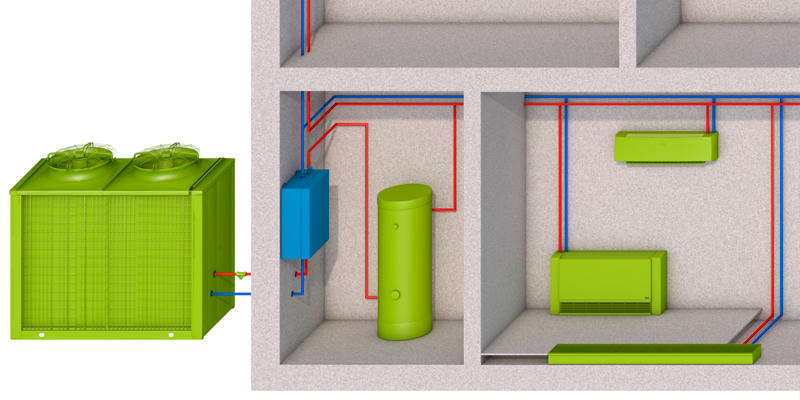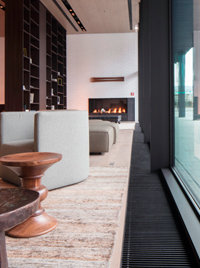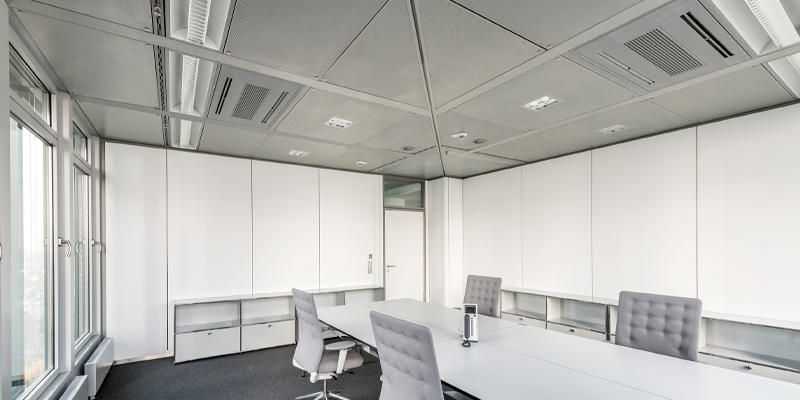The installation of chillers/heat pumps is considerably simplified by the use of the hydraulic box. Heating engineers can save themselves valuable design and installation time and the range of cooling solutions they can offer is finally extended with additional attractive products.
The cooling of buildings is work that can also be of interest to building services tradespeople who have predominantly worked in heating up to now. They have the knowledge and expertise to add cooling solutions to the range of work they offer.
The developments around the F-Gas Regulations mean that cooling solutions that use minimal quantities of coolant are growing in importance. The combination of chiller/heat pump with water-based indoor units for air conditioning is becoming increasingly popular.
Kampmann is simplifying the installation of these air conditioning solutions with its hydraulic box. It contains all the important components to separate the primary and secondary circuit, simplifying contractors’ work.
All the components are housed within a vapour diffusion-tight, foam-insulated and impact-resistant casing, obviating the time-consuming work of insulating the individual components.
The box includes a stainless steel plate heat exchanger and a dirt trap, as well as a speed-controlled circulation pump to ensure energy-saving operation.
The box comes in outputs of 12, 20 and 35 kW as an accessory for all KaClima chiller/heat pump models. Exact adaptation to higher output requirements is also possible by combining multiple units.
A wide range of Kampmann room units is available to transform the chiller/heat pump and hydraulic box concept into a well thought-out cooling system. Besides Katherm HK trench heaters, various fan coil models also meet the needs of the most diverse types of room. Katherm HK, as well as Venkon, KaDeck and KaCool D fan coils, all provide both heating and cooling functions. And not forgetting chilled ceiling systems, which provide a level of comfort to meet the most exacting comfort and acoustics requirements.
The Katherm HK trench heater is perfect for the ongoing architectural trend for large-scale glazed façades. The units blend unobtrusively into the usable floor area, and do not block the view through the floor-to-ceiling windows in any way. The cooling requirements of buildings are rising due to the latest insulation standards, a development that Kampmann is addressing with the maximum size of Katherm HK that is designed for high cooling loads. Katherm HK works with fan assistance, enabling it to operate with moderate flow temperatures, both in cooling and heating mode (low-temperature operation).
In offices, Venkon fans coils can be installed as wall- or ceiling-mounted units. They deliver fast response times thanks to their fan-assisted convection coupled with market-leading minimum noise levels.
The KaDeck is another Kampmann fan coil. The focus of this unit is on its low installation height. As an in-ceiling unit, it has a height of only 160 mm. Depending on its positioning in the room, KaDeck has one or two air outlet strips. The Coanda effect is always ideally exploited so that the cooled air ‘adheres’ to the ceiling of the room and then falls draught-free into the room.
The KaCool D fan coil is designed specifically to provide this comfortable indoor climate: it is used in large spaces, like conference rooms or also in restaurants. The AtmosFeel technology fitted in the KaCool D delivers optimised draught-free air guidance, even at high volumetric flows.
Kampmann’s broad-based portfolio of products also includes chilled ceilings, which are becoming increasingly popular on the market. Chilled ceilings, whether plasterboard or metal ceilings, provide silent cooling and moderate flow temperatures. Continuous closed runs of chilled ceilings are widely used. The convective proportion of the system is higher in the configuration consisting of multiple chilled ceiling sails between which room air can circulate. This significantly increases the total cooling output together with the predominant radiant proportion.
The key issues relating to the cooling of buildings are discussed on the Cooling information page.





